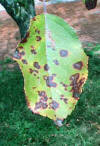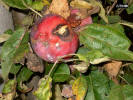|
 |
|
 |
|
 |
|
 |
 |
 Apple
scab is a fungal leaf and fruit disease. The fungus,
Venturia inaequalis, over winters in infected fallen leaves and
fruit. The severity of the disease varies with the weather
and the susceptibility of the hosts. Although this disease
is not fatal to a plant, continued infection and defoliation
weakens the plant allowing other diseases and pests to take
hold. Apple
scab is a fungal leaf and fruit disease. The fungus,
Venturia inaequalis, over winters in infected fallen leaves and
fruit. The severity of the disease varies with the weather
and the susceptibility of the hosts. Although this disease
is not fatal to a plant, continued infection and defoliation
weakens the plant allowing other diseases and pests to take
hold.
The disease attacks apples
(Malus),
crabapples
(Malus), pear
(Pyrus), quince
(Chaenomeles), mountain ash
(Sorbus), and other species.
The fungus has two types of spores. The initial or primary
infection forms on fallen fruit and leaves from the previous
year and is blown by the wind onto the new leaves in the
spring.
The second type of spore
germinates from the primary spore and is spread by splashing
rain or irrigation water. A warm, wet, humid spring will
encourage the infection to spread to adjacent leaves and
plants. If the summer is also particularly wet, further
infections will continue to occur.
|
 |
|
 |
 |
 Symptoms appear first on the young
leaves in spring as brown to olive green spots on either side of the
leaf surface. Heavy attacks can affect entire leaves turning them yellow
and then brownish in color. On older leaves, the spots appear velvety
black and slightly raised. As the disease develops, the leaves usually
turn yellow and drop prematurely. Blossoms have similar symptoms to the
leaves. The fruit is deformed by dark olive colored spots that are
sunken, causing the fruit to be corky. Symptoms appear first on the young
leaves in spring as brown to olive green spots on either side of the
leaf surface. Heavy attacks can affect entire leaves turning them yellow
and then brownish in color. On older leaves, the spots appear velvety
black and slightly raised. As the disease develops, the leaves usually
turn yellow and drop prematurely. Blossoms have similar symptoms to the
leaves. The fruit is deformed by dark olive colored spots that are
sunken, causing the fruit to be corky.
|
 |
 |
 |
The key to prevention of this
disease is plant selection. Avoid species that are very susceptible to
this disease, such as
mountain ash and quince.
When selecting a
crabapple,
be sure to check its resistance to apple scab. There are many other cultivars being developed,
and currently on the market that are resistant to apple scab. See the
plant list below.
|
 |
 |
 |
Control of this disease requires
diligence. Begin with sanitation. Clean the area around
previously infected plant by raking up fallen leaves and fruit to
eliminate some of the inoculum spores. This must be done before new
leaves open in the spring.
The second step may be
chemical
sprays for plants having a history of repeated or heavy infections.
Fungicidal sprays will effectively control apple scab if applied
regularly. Remember, the initial spores are carried by the wind from
other infected plants. Application must first occur when the flower buds
are showing a half inch of green tissue.
The Midwest usually has very wet springs,
so application will need to be repeated every 14 days, or whenever dew
or rain threatens to wet the leaves for over six hours. If the summer is
also very wet, additional spraying may be required. Usually three or
four sprayings at 10-14 day intervals starting in the early spring when
the buds swell will prove sufficient on ornamental crabapples. For
fruiting trees, sprays should continue until close to harvest. Follow
directions on the
fungicide label to determine when to stop applications
prior to harvest of the fruit.
|
|
 |
|
Note: We
have provided some general information and
observations on this topic aimed at the home
gardener. Before you take
any serious action in your landscape, check
with your state's land grant university's
Cooperative
Extension
Service for the most current,
appropriate, localized recommendations. |
|
 |
 |
 |
|
Common crabapple cultivars and species: |
|
|
 |
|



